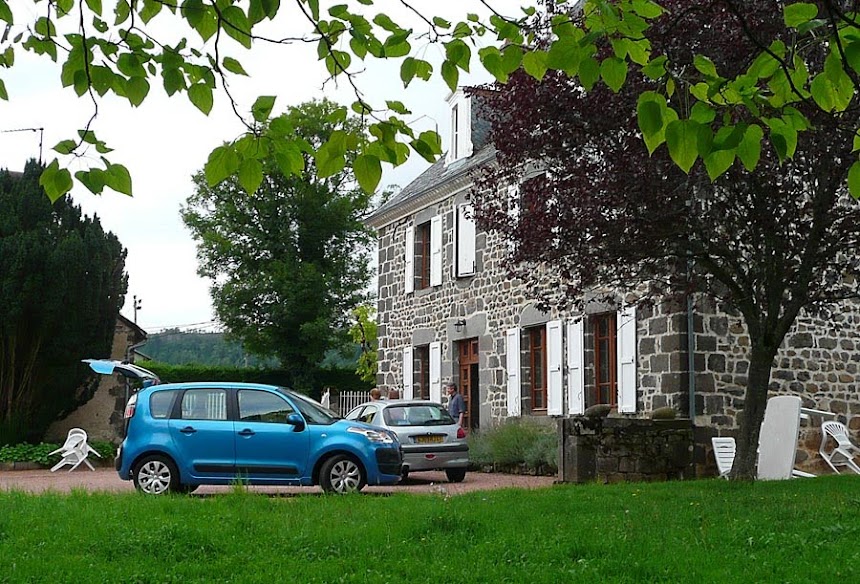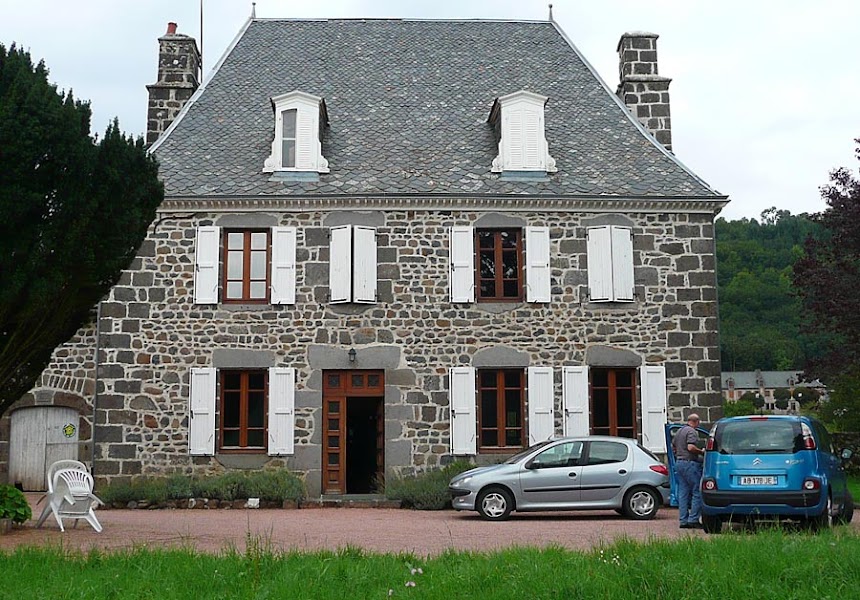The route took us on little roads out of Saint-Aignan toward the southeast, passing through Nouans-les-Fontaines, Ecueillé, and Levroux. At Brion, we got onto the A20 autoroute and headed south past Châteauroux, Argenton-sur-Creuse, and Limoges. Just south of Uzerche we exited the autoroute and drove along smaller, twisty roads through Tulle and Argentat, in the direction of Aurillac. We had arrived in Auvergne.
Our gîte (pronounced [zheet]) or rental house was in the village of Saint-Chamant, just 25 km/15 mi. north of the town of Aurillac, which we ended up not visiting at all, and near the old town of Salers, which we did spend some time in. We did visit the town of Mauriac, about 15 miles north of Saint-Chamant.
The village of Saint-Chamant (pop. 280) and nearby Salers lie inside the Parc Naturel Régional des Volcans d'Auvergne, which was created in 1977. At 4000 km2/1550 sq. mi., the Auvergne Volcano Park is the largest regional park in France. All the volcanoes are extinct — as far as geologists can tell — and the tallest ones reach nearly 1900 meters — just over 6,000 ft.
When we got to Saint-Chamant at about 6:00 p.m., we didn't have a lot of trouble finding the house we had rented. The owner had told me it was just across the street from the village's athletic field, and there was a sign pointing that way as we drove into town. We weren't sure which house it was, so we called Madame Dauzet on a cell phone and she gave us directions. It turned out we had stopped right in front of the house she lives in.
Mme Dauzet followed us a few hundred yards back up a hill on a narrow lane. Coming to the house from that direction, we could see it in front of us and we recognized it from photos we had seen on the Internet. It only took Mme Dauzet a few minutes to show us around the place, familiarizing us with the kitchen, the furnace, and the fireplace (in case the weather stayed cool).
 The living room, with its enormous fireplace —
The living room, with its enormous fireplace —fortunately, it wasn't chilly enough for us to need a fire.
It was foggy and gray outdoors, but it wasn't raining. Night was falling. The landscape reminded me of being in the Appalachian Mountains in the U.S. — West Virginia, for example, or the mountains of North Carolina.
The house was huge, as you can see from the pictures in this post. I didn't take pictures of the bedrooms — not sure why — but I can tell you that all three of them were very spacious. In fact, the house was at least twice, maybe three times, the size of our house in Saint-Aignan. There were two full bathrooms. Mme Dauzet said she and her husband were in the process of renovating it, with the idea of living there themselves, when her husband fell ill and died a few years ago.
For a while, she let the place stand empty, but after a while she decided to finish off the restoration and renovation work and rent the house out to vacationers as a gîte rural. We paid the shoulder-season rate of 360 euros for the week, which was very reasonable (72 euros per person). Even though we stayed only 3 or 4 nights, and not all 7, we thought it was a bargain. The high-season rate is 500 euros/week ($700 or so). The place sleeps 6 or even 7 people, easily.
It was about a 10-minute walk up into the village, where there was a church, a hotel, and one little grocery store. That was about it. Oh, and a château, of course. I'll be posting pictures of all these places over the next week or so, as well as pictures of Salers, our drives through the park, a couple of nearby châteaux, and our encounters with cows and cheese producers.









The style of the dressers in the dining room is known as Henry II. This late Renaissance style was in vogue at the end of the XIXth century. But, here, as everywhere else in France's dining rooms of the time, it is a genuine faux improved Henry II!
ReplyDeleteHenry II was the son of Francis I who built Chambord.
What a lovely place. My (great)grandparents had similar dressers ... but my parents had to get rid of them due to lack of space in our house :(. What a waste! Martine
ReplyDeleteI love the photos you took- it would have been fun to spend a whole week in this comfortable home. I think shoulder season is the way to go- not too hot and still not chilly enough for a fire.
ReplyDeleteWe slept like logs in our bedroom.
What a lovely place. Can't wait to see more photos.
ReplyDeleteKen, thanks for this post! My sisters and I are always (unusually) interested in hotels and other vacation lodging that people choose... I guess it's to help us live vicariously through them, or, perhaps, to fuel our imaginations for planning potential trips... always in the back of my mind, that's for sure! This gîte will lead to lots of dreaming:))
ReplyDeleteI think I maybe mentioned that I visited the volcano park at Easter vacation, with my au pair family?
CHM, thanks for the history tidbit. I looked at that furniture and wondered about it. I'm very pleased to know the era of its style. My teaching unit last year on Medieval and Renaissance châteaux had me reading frequently about François 1er and Henry, but I had already forgotten Henry's number--and, I always associate the name Henry II with England's Plantagenet king, so I had to do a double-take.
Judy
Ken (or anyone who'd like to comment), how would you translate the phrase a priori (other than the same way)? I've been following a sad news story of the little girl who had been reported missing, and they quoted the prosecutor as saying, "A priori, il n'y a pas de traces de violences apparentes." I'm thinking something like, "In theory..." or "At this point..." or "It looks, on the face of it, that..." What would you suggest as a good translation?
ReplyDeleteThanks,
Judy
I would say "on the face of it" or "our first impression is...", something like that. Here's what the Robert-Collins dictionary has:\
ReplyDeletea priori [ apYijCYi ]
1 locution adverbiale
Philosophie a priori
en général ; intéressant, surprenant at first sight
refuser qch a priori : to refuse sth out of hand
a priori, la date ne devrait pas changer : in principle, the date shouldn't change
tu es libre samedi? -- a priori oui : are you free on Saturday? -- I should be
2 locution adjective
Philosophie a priori
3 nom masculin invariable
Philosophie apriorism
en général prejudice
avoir des a priori : to be biased ou prejudiced (envers : towards ) (contre : against )
j'ai abordé le problème sans a priori : I approached the problem with an open mind
That might be kind of hard to decipher because of the formatting.
Judy, I could be wrong but I would think you could translate "a priori" by "from what we know so far" depending on the context (particularly when it is the beginning of an investigation)
ReplyDeleteGreat photos. At least your gite was easy to find. We always seem to choose ones that are hidden away and impossible to find. Not that we need one any more - but you never know.....
ReplyDeleteJudy/Ken
ReplyDeleteIn the context of the story ( I believe it is about the little girl Sabatier) I woul dsay "at the first examination"
Judy, the translation of the sentence you give might be: "As far as we can tell, there are no apparent signs of violence" or "so far, we have seen no evidence of abuse..."
ReplyDeleteExcellent help on translating, Ken, Nadege, and The Beaver :) Thanks so much!
ReplyDeleteJudy
Wow, €360 per week is a bargain for a place that nice.
ReplyDeleteStarman, I know you have rented apartments in Paris, but have you ever rented a gîte out in the French countryside? The gîtes are a lot less expensive, and even with the cost of a car rental and fuel, you can come out way ahead financially compared to Paris apt. rental prices. And everything else is less expensive out in the country too -- groceries, restaurants, etc. €300 to €500 a week for a gîte rural is typical.
ReplyDeleteWe saw this Picasso at the wonderful Cezanne-Picasso exhibit in Aix:
ReplyDeletehttp://www.duvarpaper.com/main.php?g2_itemId=3413&g2_imageViewsIndex=1
chien and Henri II buffet.-)
Evelyn, that's fantastic. What at good coincidence. Buffet Henri II, nice.
ReplyDelete